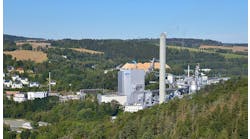"We didn't know how to top last year's skit," began Rockwell Automation's Kris Dornan, "so we just went for it."
Dornan and colleagues Andy Stump and Dave Knowles updated their "Day in the Life" demonstration series for the PlantPAx process automation platform this week at the Rockwell Automation Process Solutions User Group (PSUG) meeting in Orlando, in conjunction with the company's 2010 Automation Fair.
Clearly, Dornan and company succeeded in creating some memorable images among the record 600-plus PSUG attendees: six volunteers pretending to be outputs from a 3oo3 TMR safety system by raising their hands every time a green light went on; the unison speech from Dornan and Stump demonstrating control system redundancy; and moderator Knowles throwing PlantPAx hats into the audience to the refrain of "PlantPAx can do that!" all contributed to a general merriment.
But beneath the merriment was a very important message, both technical- and marketing-oriented. This year, video clips of end users in various vertical industries and functional roles shared their pain points and asked, "Can PlantPAx help me with that?" The point that Knowles, Dornan and Stump were trying to make is that many industrial users have very similar problem sets and issues, but no one solution fits all of them. But PlantPAx, they noted, especially in its 2.0 release announced this week, is powerful enough and flexible enough to be easily customized to solve each industry vertical's major problems simply and effectively. "PlantPAx is the answer to solving critical business issues," Dornan said.
"PlantPAx is the answer to solving critical business issues." Rockwell's Kris Dornan explained the new PlantPAx 2.0 features designed to increase availability as well as boost operational and design productivity.
To demonstrate the capabilities of PlantPAx 2.0, Stump and Dornan first took on risk management and risk reduction, noting that PlantPAx now includes "trusted TMR" safety instrumented systems (from the ICS Triplex acquisition) and the AADvance system that is designed for simpler systems and for offshore safety systems. "Trusted TMR and the AADvance system are all part of the Integrated Architecture that is the basis for PlantPAx," Stump said. "They've been integrated into the Logix platform, and the TUV-rated SIL2 redundant controllers are scaleable to any size control system."Machine safety was raised as a key pain point for the food and beverage industry, and PlantPAx can provide a complete integrated common platform for SIL2 solutions for machine safety too, Dornan added.
For the power industry vertical, Dornan and Stump concentrated on the platform's networking and security enhancements. Rockwell Automation can provide security consulting services beginning with the assessment phase, including assessing the existing security program, the network design, and the current implementation; assist with designing and planning improvements to the security structure, and move directly into implementation, Stump said.
Rockwell Automation's security practices are built around the FactoryTalk services platform, which forms a key part of the PlantPAx Integrated Architecture, and is based on Cisco's recommended network practices. Once the system is secure, continuous audit, management and monitoring programs can also be provided.
PlantPAx 2.0 also features redundant I/O for Logix. There's a common, redundant backplane, operating on a redundant Ethernet network with dual ports. "You'd think this would make things doubly complicated, wouldn't you?" Dornan said. "But in the Engineering Workstation view, the redundant pairs are shown as if they were a single item—no confusion, very easy."
In addition, Dornan noted, both controllers can be separated for safety and accident prevention, so that if one controller is in a flood, for example, the other bumplessly takes over, regardless of where it is located. The redundancy extends to ControlNet and Ethernet, and there's redundant HMI support. No single failure will bring the network down.
PlantPAx's capability to make changes to the controller program while running, without affecting either the rest of the physical controller or program, is intended to maximize uptime and availability. For hardware, just add the card to the chassis. For software, there's now an online edit feature that allows you to add I/O online, update all data references, test and revert online code while running, and make redundant changes to controllers and HMI systems using PlantPAx global objects.
In the next video clip, a consumer packaged goods industry user wanted diagnostics, and PlantPAx can do that, too, with HART diagnostics embedded in the controllers and the network. Controller recovery can be done with onboard nonvolatile memory cards that can transfer programs from one controller to another.
A key feature of PlantPAx is the large library of decision support tools that Dornan called "information-enabled and result-ready." Using Dynamix Alarms, FactoryTalk Vantage Point, PlantPAx Model Builder and a variety of dashboard and "what if" tools, users have a comprehensive decision-support system at their service.
PlantPAx also has a library of pre-built content—faceplates with common look and feel, a comprehensive engineering interface and operator control stations, and a common object model with breadcrumbs that enable the engineer and the user to handle many different industry verticals with a single design and control tool. Templates for many different plant types and industries have been developed, and advanced tools like embedded steam tables and a complete suite of Advanced Process Control and Model Predictive Control tools are able to show that "PlantPAx can do that."
Finally, Dornan said, Rockwell Automation's customers are in pain over the changes that come from using commercial off-the-shelf (COTS) computers. "Computer changes come every 11 days," he said, "and major operating system releases average 1.2 years apart." The solution is virtualization, which "separates the computing from the computer, and the system's life is no longer limited by hardware."
All in all, a very impressive array of features for the new PlantPAx 2.0, released here at Automation Fair and the PSUG meeting.




